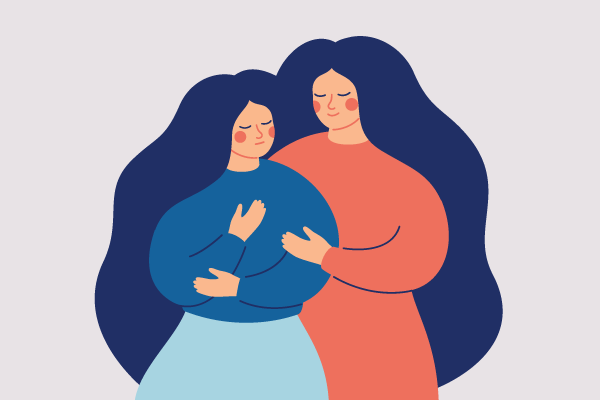‘I Feel Your Pain’: The Neuroscience of Empathy

Whether it’s watching a friend get a paper cut or staring at a photo of a child refugee, observing someone else’s suffering can evoke a deep sense of distress and sadness — almost as if it’s happening to us. In the past, this might have been explained simply as empathy, the ability to experience the feelings of others, but over the last 20 years, neuroscientists have been able to pinpoint some of the specific regions of the brain responsible for this sense of interconnectedness. Five scientists discussed the neuroscience behind how we process the feelings of others during an Integrative Science Symposium chaired by APS Fellow Piotr Winkielman (University of California, San Diego) at the 2017 International Convention of Psychological Science in Vienna.
Mirroring the Mind

Cultural emphasis on ingroups and outgroups may create an “empathy gap” between people of different races and nationalities, says Ying-yi Hong.
“When we witness what happens to others, we don’t just activate the visual cortex like we thought some decades ago,” said Christian Keysers of the Netherlands Institute for Neuroscience in Amsterdam. “We also activate our own actions as if we’d be acting in similar ways. We activate our own emotions and sensations as if we felt the same.”
Through his work at the Social Brain Lab, Keysers, together with Valeria Gazzola, has found that observing another person’s action, pain, or affect can trigger parts of the same neural networks responsible for executing those actions and experiencing those feelings firsthand. Keysers’ presentation, however, focused on exploring how this system contributes to our psychology. Does this mirror system help us understand what goes on in others? Does it help us read their minds? Can we “catch” the emotions of others?
To explore whether the motor mirror system helps us understand the inner states behind the actions of others, Keysers in one study asked participants to watch a video of a person grasping toy balls hidden within a large bin. In one condition, participants determined whether or not the person in the video hesitated before selecting a ball (a theory-of-mind task). Using transcranial magnetic stimulation (TMS) in combination with fMRI, Keysers showed that interfering with the mirror system impaired people’s ability to detect the level of confidence of others, providing evidence that this system indeed contributes to perceiving the inner states of others. Performing fMRI and TMS on other brain regions such as the temporoparietal junction (TPJ) further suggests that this motor simulation in the mirror system is then sent onward to more cognitive regions in the TPJ.
“Very rapidly, we got this unifying notion that when you witness the states of others you replicate these states in yourself as if you were in their shoes, which is why we call these activities ‘vicarious states,’” Keysers said.
Studies have suggested that this ability to mentalize the experiences of others so vividly can lead us to take prosocial steps to reduce their pain, but Keysers also wanted to investigate the depth of this emotional contagion — how and to what extent we experience other people’s suffering. To do this, Keysers’ lab studied two very different populations: human psychopaths and rats.
While witnessing the pain of others is correlated with activity in the insula, which is thought to contribute to self-awareness by integrating sensory information, and the anterior cingulate cortex (ACC), which is associated with decision making and impulse control, the researchers found that psychopaths who passively observed an aggressor twisting someone’s hand exhibited significantly less brain activity than their neurotypical peers. When the psychopathic individuals were asked to attempt to empathize with the person in the video, however, their brain activity increased to baseline levels.
This suggests that the current model of empathy as a one-dimensional scale with empathic individuals at one end and psychopaths at the other may be overly simplistic, Keysers said.
“Psychopaths are probably equally high on ability, it’s just that they don’t recruit this spontaneously, so their propensity is modified,” he explained.
These findings could lead to more effective interventions for psychopathic individuals, as well as to future research into where people with autism spectrum disorders may fall on these axes.
Shared Pain
Studies of emotional contagion in animal models have allowed researchers to further examine the role of deep brain activity, which can be difficult to neurostimulate in humans. Keysers’ work with rats has found that these animals are more likely to freeze after watching another rat receive an electric shock if they themselves had been shocked in the past.
Inhibiting a region analogous to the ACC in the rats’ brains reduced their response to another rat’s distress, but not their fear of being shocked themselves, suggesting that the area deals specifically with socially triggered fear, Keysers said.
Claus Lamm, University of Vienna, investigates the processes that regulate firsthand pain and those that cause empathy for pain through numerous studies on the influence of painkillers.
In these experiments, participants who took a placebo “painkiller” reported lower pain ratings after receiving a shock than did those in the control group. When those same participants watched a confederate get shocked, they reported a similar drop in their perception of the actor’s pain.
“If you reduce people’s self-experienced pain, if you induce analgesia, that not only helps people to deal with their own pain, but it also reduces empathy for the pain of another person,” Lamm said.
On the neural level, Lamm said, fMRI scans showed that people in the placebo group displayed lower levels of brain activity in the anterior insula and mid cingulate cortex in both cases. These results were further confirmed in another study that compared participants who received only the painkiller placebo with those who received both the placebo and naltrexone, an opioid antagonist that prevents the brain from regulating pain.
This resulted in a “complete reversal” of the placebo effect, causing participants to report both their own pain and the pain of others at near baseline rates, supporting Lamm’s previous claims about the pain system’s role in empathy.
“This suggests that empathy for pain is grounded in representing others’ pain within one’s own pain systems,” Lamm said.
The Self/Other Divide
Empathy may not give us a full sense of someone else’s experiences, however. When observers in one of Keysers’ studies were given the opportunity to pay to reduce the severity of the electric shocks a confederate was about to receive, on average participants paid only enough to reduce her pain by 50%.
Lamm studied this self/other distinction through a series of experiments that measured people’s emotional egocentricity bias. To do so, participants were presented with visuo-tactile stimulation that was either congruent or incongruent with that of a partner under fMRI. In an incongruent pair, for example, one participant might be presented with an image of a rose and be touched with something that felt like a rose, while the other was shown a slug and touched with a slimy substance.
Participants’ own emotions were found to color their perception of other people’s affect at a relatively low rate — however, when researchers inhibited the right supramarginal gyrus (rSMG), a region of the brain previous associated mainly with language processing, this egocentricity bias increased, suggesting that the rSMG may be responsible for maintaining a self/other divide, Lamm said.
“Empathy not only requires a mechanism for sharing emotions, but also for keeping them separate. Otherwise we are getting ‘contaged,’ emotionally distressed and so on,” he said.
The rate of rSMG activation also changes significantly across a lifetime, Lamm added, with the area’s developmental trajectory causing emotional egocentricity to be more common in adolescents and the elderly.
Developing Division

Researchers are working to unite neuroscientific and psychological perspectives on feelings, empathy, and identity, says Piotr Winkielman.
Rebecca Saxe (Massachusetts Institute of Technology) said her work with developmental psychology confirms this trend. In one series of experiments, Saxe monitored the brain networks that 3- to 5-year-old children used to consider a character’s mind (the temporoparietal junction, posterior cingulate, and prefrontal cortex) and body (the secondary somatosensory cortex, insula, middle frontal gyrus, and ACC) throughout a short film.
Saxe found that while these brain regions may interact with each other, there were no points of overlap between the mind and body networks’ activities.
“When we’re getting information from the same source and about the same people, we still nevertheless impose a kind of dualism where we alternate between considering what their bodies feel like and the causes of their minds,” Saxe said.
Furthermore, Saxe and her colleagues found that while these networks were more distinct in children who were able to pass an explicit-false-belief task (e.g., if Sally puts her sandwich on a shelf and her friend moves it to the desk, where will she look for it?), the division was present in participants of all ages.
“Most people have treated explicit false belief as if it were the milestone,” Saxe said. “Actually, the false-belief task is just one measure of a much more continuous developmental change as children become increasingly sophisticated in their thinking about other people’s minds.”
Next, Saxe scaled this experiment down to test the theory of mind of infants as young as 6 months, this time measuring their response to children’s facial expressions, outdoor scenes, and visual static. This time period may be key to understanding the neuropsychology of empathy because most of the brain’s cognitive development happens within the first year of life, she explained.
“A baby’s brain is more different from a 3-year-old’s brain than a 3-year-old’s brain is from a 33-year-old’s brain,” Saxe said.
Under fMRI, the infants’ brains were found to have many of the same regional responses that allow adults to distinguish between faces and scenes. Their brains didn’t show any regional preferences for objects and bodies, however.
This level of regional specificity suggests that the Kennard Principle, the theory that infants’ brains possess such resilience and plasticity because the cortex hasn’t specialized yet, may be only partially true. There does appear to be some functional organization of social process, Saxe said, with gradually increasing specialization as the child ages.
Empathy in Action

Brian D. Knutson says analysis of individuals’ brain activity when considering a purchase may be predictive of aggregate market choices.
On the surface, neuroforecasting sounds like a concept that would be right at home in the world of Philip K. Dick’s Minority Report — a science fiction thriller about a society that stops crime before it happens based on the brainwaves of three mutant “precogs” — said APS Fellow Brian D. Knutson (Stanford University), but someday it could play a very real role in the future of economics.
Knutson’s research on the brain mechanisms that influence choice homes in on three functional targets: the nucleus accumbens (NAcc) for gain anticipation, the anterior insula for loss anticipation, and the medial prefrontal cortex (mPFC) for value integration.
Using fMRI, Knutson was able to predict participants’ purchases in a simulated online shopping environment on the basis of brain activations in these areas. Before participants chose to buy a product, increased activity in the NAcc and mPFC was paired with a decrease in the insula, while the reverse was true of trials in which participants chose not to make a purchase.
“This was very exciting to me as a psychologist to be able to say, ‘Wow, we can take activity out of the brain and, not knowing anything else about who it is and what product they’re seeing, we can predict choice,’” Knutson said.
His economist colleagues weren’t as impressed: They were interested in market activity, not individual choice. Knutson said he accepted this challenge by applying his neuroanaylsis to large-scale online markets such as Kiva and Kickstarter.
Knutson asked 30 participants to rate the appeal and neediness of loan requests on Kiva and found that posts with photos of people displaying a positive affect were most likely to trigger the increased NAcc activity that caused them to make a purchase — or in this case, a loan. More importantly, the averaged choices of those participants forecasted the loan appeal’s success on the internet. Two similar studies involving Kickstarter campaigns also suggested a link between NAcc activity and aggregate market activity.
While brain activity doesn’t scale perfectly to aggregate choice, Knutson said, some components of decision making, such as affective responses, may be more generalizable than others.
“The paradox may be that the things that make you most consistent as an individual, that best predict your choices, may not be the things that make your choices conform to those of others. We may be able to deconstruct and decouple those components in the brain,” Knutson said.
Global Empathy
The neuroanatomy of our brains may allow us to feel empathy for another’s experiences, but it can also stop us from making cross-cultural connections, said APS Fellow Ying-yi Hong (Chinese University of Hong Kong).
“Despite all these neurobiological capabilities enabling us to empathize with others, we still see cases in which individuals chose to harm others, for example during intergroup conflicts or wars,” Hong said.
This may be due in part to the brain’s distinction between in-group and out-group members, she explained. People have been found to show greater activation in the amygdala when viewing fearful faces of their own race, for example, and less activation in the ACC when watching a needle prick the face of someone of a different race.
The cultural mixing that accompanies globalization can heighten these responses, Hong added. In one study, she and her colleagues found that melding cultural symbols (e.g., combining the American and Chinese flags, putting Chairman Mao’s head on the Lincoln Memorial, or even presenting images of “fusion” foods) can elicit a pattern of disgust in the anterior insula of White Americans similar to that elicited by physical contaminant objects such as insects.
These responses can also be modulated by cultural practices, Hong said. One study comparing the in-group/out-group bias in Korea, a more collectivist society, and the United States, a more individualistic society, found that more interdependent societies may foster a greater sense of in-group favoritism in the brain.
Further research into this empathy gap should consider not just the causal relationship between neural activation and behavior, she said, but the societal context in which they take place.
“What I want to propose,” Hong said, “is that maybe there is another area that we can also think about, which is the culture, the shared lay theories, values, and norms.”





Comments
There is some fantastic research going on in empathy. From an evolutionary point of view however it’s important to distinguish an evolved motivation system from a competency. Empathy is a competency not a motivation. Empathy can be used for both benevolent but also malevolent motives. And psychopaths have a competency for empathy but what they lack is mammalian caring motivation. Insofar as part of the reproductive strategy of the psychopath is to exploit others and even threaten them then having a brain that turns off distress to the suffering they cause would be an advantage to them. Psychopaths are much more likely to be prepared to harm others to get what they want. Mammalian caring motivation, when guided by higher cognitive processes and human empathy gives rise to compassion. Without empathy compassion would be tricky but without compassion you can still have empathic competencies
Gilbert, P. (2017). Compassion as a social mentality: An evolutionary approach. In: P. Gilbert (ed). Compassion: Concepts, Research and Applications. (p. 31-68). London: Routledge
Gilbert. P. (2015). The evolution and social dynamics of compassion Journal of Social & Personality Psychology Compass, 9, 239–254. DOI: 10.1111/spc3.12176
Catarino, F., Gilbert, P., McEwan., K & Baião, R. (2014). Compassion motivations: Distinguishing submissive compassion from genuine compassion and its association with shame, submissive behaviour, depression, anxiety and stress Journal of Social and Clinical Psychology, 33, 399-412.
Gilbert, P., Catarino, F., Sousa, J., Ceresatto, L., Moore, R., & Basran, J. (2017). Measuring competitive self-focus perspective taking, submissive compassion and compassion goals. Journal of Compassionate Health Care, 4(1), 5
Very interesting article. The research behind what links our empathy to our actions determining the agenda is fascinating. As social creatures, we seem to inhibit empathetic tendencies naturally in our genetic makeup when studied. Since we have the highest empathetic behavior compared to other animals, who also show empathetic behavior, I wonder if it falls more on our social norms. What we consider relatable is worthy of our empathy. If we don’t relate, we may be less inclined to put ourselves in the other position.
I have what I call empathy pain. It radiates an aching pain in my legs and I can barely stand it. I’ve googled it in attempts to validate it is real. It seems people either do not believe me or can’t understand stand when I tell them it makes my legs ache. Seeing someone’s cuts, surgical incisions, bloody wounds. I can’t describe all the triggers, but I can 100% say the pain I feel in response is intense, even when they say “oh, it didn’t hurt” or “it’s not hurting”. Well, it hurt ME seeing it.
I am currently writing a literature review for my psychology course in University, based on what I am writing about I believe you may have Mirror Touch Synesthesia. This condition is characterized by viewing others being touched and feeling tactile sensations, and this seems quite similar to what you shared. I would recommend doing a bit of research on MTS, and see if it relates to you.
Since I was 7 years old I felt others pain Then I thought everyone could .
I came to realize I feel so much more than most . I feel what I see, I feel what I hear. My sensitive to touch is more like pain but my pain level is very high, I can take a lot of pain.
What about feeling pain or illness without observing it or even having knowledge of someone else’s pain? Such as the phenomenon of twins. I’m looking for research of this outside of the twin sibling relationship.
When carrying out functional mapping of the amygdala cortex by means of electrical stimulation in one of my patients with focal epileptic seizures who was being evaluated for resective epilepsy surgery of the orbitofrontal, opercular, and anterior insular cortex the stimulation caused the patient to reminisce over video films he had seen of cartoons (animaniacs) as a child, at the same time empathizing with the suffering of those characters. I had probably activated a limbic pathway connected to the limen insulae where I was administering electrical stimulation at that time. The visual imagery stopped as soon as the stimulus train was over but the patient still empathized with the cartoon characters for about 20 seconds after the stimulation was over and reported his feelings to me.
Wow… I thought I was alone in the way I feel everyone’s pain and joy. I find that I can not watch scenes of torture or violence on tv, thus I hate most movies, unless it’s a children flick. I get pulled into every story I read. On 911 I thought my heart really was breaking, it consumed my entire body. I can’t watch history shows of Pearl Harbor, or nazis. If I do, sometimes those images stay with me for years and come back as nightmares. It’s not easy living with this in today’s world.
APS regularly opens certain online articles for discussion on our website. Effective February 2021, you must be a logged-in APS member to post comments. By posting a comment, you agree to our Community Guidelines and the display of your profile information, including your name and affiliation. Any opinions, findings, conclusions, or recommendations present in article comments are those of the writers and do not necessarily reflect the views of APS or the article’s author. For more information, please see our Community Guidelines.
Please login with your APS account to comment.